|
|
|
Sort Order |
|
|
|
Items / Page
|
|
|
|
|
|
|
| Srl | Item |
| 1 |
ID:
169876


|
|
|
|
|
| Summary/Abstract |
As part of Germany's energy transition, enormous efforts are being made to transform the German energy supply to renewable energies. While much of the energy supply from renewables is wind and solar power, biogas contributes on third position a considerable share due to substantial state subsidies. The transformation to renewable energies leads to notable landscape changes that should be taken into consideration when studying the acceptance of renewable energy plants. We do this by adding spatial information to data from an online survey (N = 942) questioning the acceptance of biogas plants. The density of and proximity to existing biogas plants as well as the intensity of maize cultivation in the vicinity of respondents is integrated into the analysis together with more conventional influencing factors such as place attachment and attitudes. Results show that attitudes have the strongest explanatory power but spatial variables, particularly maize intensity, contribute significantly, too. Place attachment does not show reliable effects. The results demonstrate that spatial data can be useful in the analysis of survey data, for instance, in an environmental context. They also show that diversification of the raw materials used for fermentation in biogas plants might be an important factor in improving their acceptance.
|
|
|
|
|
|
|
|
|
|
|
|
|
|
|
|
| 2 |
ID:
169885
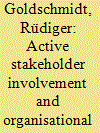

|
|
|
|
|
| Summary/Abstract |
Derived from a field research lab, this article contributes empirical results to the discussion on how communication and governance strategies can be effectively developed to promote the electrification of the taxi business (e-taxi business). The conceptual section indicates the relevance of this discussion. Based on multi-method research, a main finding is that, besides the relevant discussions on the technical aspects, organisational and social development tasks should be considered. Communication and governance strategies have to be flexibly adapted to the dynamics, uncertainties and especially heterogeneities raised by the specific settings. Thus active, deliberative and long-term stakeholder involvement based on an effective project network of capable organisations constitutes a central success factor and resource for developing a working e-taxi fleet in a conventionally orientated traffic environment. The article develops general and specific recommendations on how this can be designed and implemented. Based on empirical social research on attitudes and perceptions, for instance, existing user typologies will be elaborated upon. This supports the communication used for attracting entrepreneurs to participate in a planned developmental project and for involving entrepreneurs during the endeavour in his running stage. The article also presents organisational measures on how taxi companies coped with technical or infrastructural flaws.
|
|
|
|
|
|
|
|
|
|
|
|
|
|
|
|
| 3 |
ID:
169899
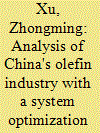

|
|
|
|
|
| Summary/Abstract |
Recently, China produces olefins increasingly from coal, although OTO (oil-to-olefins) is still dominating China's olefin industry. With the uncertain future dynamics of oil and coal prices, as well as environmental issues, how should China configure its future olefin industry? And what kind of carbon emission controlling policies should be implemented if more olefins would be produced with CTO (coal-to-olefins) in China? This paper develops a system optimization model to explore these questions. With four different scenarios of oil and coal prices, we first explore the optimal configuration of China's olefin industry without considering controlling carbon emission; then we explore the situation in which new CTO capacity must implement CCS (carbon capture and storage) for controlling carbon emission. The results of our study imply that investing in CTO technology in China is not a wrong direction, especially as a technology stock for energy safety, and it could be a good regulation to require CTO to implement CCS for achieving both economic and environmental values.
|
|
|
|
|
|
|
|
|
|
|
|
|
|
|
|
| 4 |
ID:
169900


|
|
|
|
|
| Summary/Abstract |
The future role of nuclear power in decarbonization of the US electricity grid is uncertain. Large light water plants have proven challenging to deploy, and the existing nuclear fleet is under market pressure. A new cadre of developers, supported by the US Department of Energy, is pressing for an accelerated path to deployment of new nuclear designs to address the climate challenge and maintain the nuclear industrial base. However, an examination of market dynamics and the ongoing pace of low carbon technology transition portend significant challenges for these vendors. Our analysis indicates that the current advanced reactor research and development paradigm is unlikely to yield multiple technology options in a timeframe that matters and argues for a slower and steadier “tortoise” approach. Using an optimization model we demonstrate that a slower, structured approach across a broad portfolio of technologies will better align nuclear development with a possible mid-century market opening. By allowing additional development time, building multiple demonstration plants, and operating these new designs for extended periods, it is more likely that there will be competitive technologies that can meet the future economic and technical requirements for widespread nuclear deployment should the technology be required in decarbonization efforts.
|
|
|
|
|
|
|
|
|
|
|
|
|
|
|
|
| 5 |
ID:
169897


|
|
|
|
|
| Summary/Abstract |
Project finance (PF) is a powerful tool for mobilizing capital for renewable energy (RE) projects but faces challenges in developing countries. This paper examines factors driving the financing method choice between project finance (recourse exclusively to project assets) and corporate finance (recourse to parent company assets), including the feed-in tariff (FIT), using the Philippines as a case study for a developing country. After the RE Law was approved in 2008, RE capacity increased but RE share in energy mix decreased. FIT resulted in increased investments in RE, primarily in solar and wind. Results show that PF incidence is higher for baseload, high-capacity utilization, non-intermittent technologies; non-FIT projects with revenue contracts; and larger projects owned by public companies. Contrary to expectation, PF was less utilized for FIT-eligible RE, and projects owned by private or small investors. PF was utilized primarily by well-capitalized investors, and mostly by power and financial companies. The Philippine FIT's tight deadlines and low technology-specific capacity caps increased revenue uncertainty, resulting in high concentration of project ownership and potential erosion of public support. Given the intrinsic uncertainty of RE and developing countries, policymakers need to design policies to minimize revenue uncertainty, enable PF and broaden the investor base.
|
|
|
|
|
|
|
|
|
|
|
|
|
|
|
|
| 6 |
ID:
169894
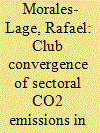

|
|
|
|
|
| Summary/Abstract |
An understanding of the evolution of sectoral CO2 emissions for all EU countries in recent decades would clearly be useful for political authorities when designing future environmental policies. This paper investigates the process of convergence in sectoral per capita CO2 emissions, with a focus on the energy sector. The concept of club convergence is used to analyse emissions in 28 EU countries from 1971 to 2012, with special attention paid to the energy subsectors (power generation and heating, manufactures and construction, transportation, and other minor fuel combustion). We find that core European countries (France, the Netherlands, Germany and the UK) are included in the best performing clubs, no matter the sector or subsector, whereas among Central and Eastern European Countries, a few diverge from the average towards higher emissions. Relative convergence among a large number of EU members would, therefore, support the relevance of both the EU abatement policy and international agreements in this process.
|
|
|
|
|
|
|
|
|
|
|
|
|
|
|
|
| 7 |
ID:
169883


|
|
|
|
|
| Summary/Abstract |
In the Swiss canton of Geneva, an energy efficiency portfolio has been operated since 2009. In contrast, such programs have been in place for more than 40 years in the US. There are numerous lessons to be learnt from their experience. We have therefore conducted a comparative analysis including Geneva and 11 leading states in the US, with the objective to identify explanatory factors for the success of energy efficiency programs. First, we compared total investment in energy efficiency programs between 2006 and 2015 and public policies related to energy efficiency in each state. Second, we analyzed the levelized cost of saved energy (LCSE) of the programs from the perspective of program administrators. Our cost-effectiveness analysis showed that the program investment scale has been strongly influenced by i) the existence of public mandates, which require program administrators to set ambitious targets and maximize their investment in cost-effective energy efficiency measures, ii) financial instruments that ensure program expenditure to be recovered, and iii) complementary funding from other programs. Moreover, learning and accumulated experience of the program administrators allow to reduce the LCSE. We conclude that the combination of financial instruments with public mandates can ensure a high level of effectiveness.
|
|
|
|
|
|
|
|
|
|
|
|
|
|
|
|
| 8 |
ID:
169889
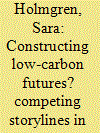

|
|
|
|
|
| Summary/Abstract |
This study examines how the European Union (EU) energy policy goals are translated in Estonia, a country heavily reliant on fossil fuel oil shale and having one of the most energy-intensive economies in the EU. Drawing on Hajer's approach to discourse and different qualitative methods, we analyse the production of different low-carbon storylines. Our findings show that state and industrial actors accommodate environmentally damaging oil shale production in low-carbon energy transformation, despite good conditions for expanding renewable energy. Additionally, they limit their ambition to transform mere technological modifications to the minimum requirements of the EU GHG emission reduction target. The socio-economic conditions of workers and people living near oil shale mining areas, primarily Estonian Russians, are a critical factor in upholding oil shale as a necessity. Despite being at the centre of dominant storylines, these people are portrayed as a category that needs to be kept at ease, rather than actively engaged in constructing acceptable sustainable routes to low-carbon futures. We conclude that in order to accelerate the decarbonisation in Estonia and beyond, and unleashing the transformative potential of EU energy policy, it is vital to make marginalised voices heard and engaged in energy policy decision-making.
|
|
|
|
|
|
|
|
|
|
|
|
|
|
|
|
| 9 |
ID:
169892


|
|
|
|
|
| Summary/Abstract |
The retail industry is one of the top 10 most carbon-intensive sectors. This paper is original in addressing what has changed in corporate retail with the Paris Agreement, accessing trends to decarbonize the sector. A qualitative comparison was performed regarding the policy, strategy and energy-related building solutions of the top 27 global retailers, ranked according to their revenue, regarding the reporting periods of 2014–2015 and 2016–2017. For each retailer, data were searched on retailers’ sustainability reports was organized in different tables according to the variables policy, strategy and energy-related building practice. A comparison analysis was carried out, in order to identify differentiating decarbonizing measures.
|
|
|
|
|
|
|
|
|
|
|
|
|
|
|
|
| 10 |
ID:
169887
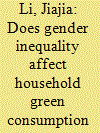

|
|
|
|
|
| Summary/Abstract |
In this paper, we examine whether gender inequality affects a household's decision to adopt green consumption behaviour in China. Building upon the literature that claims women tend to be more environmentally friendly than men, we hypothesise that households in which women play a stronger role adopt greener consumption lifestyles. Based on a nationwide survey, our empirical results show that households in counties with greater gender inequality use less energy-efficient electric products and are less willing to save energy. The results are robust to a number of variations in our empirical models. Social and economic factors are included to further explore the mechanisms underlying households' decisions. Our findings provide new insights into green development from a micro-level, bottom-up perspective. They are relevant for policy makers because they indicate that promoting gender equality can have a favourable impact on green development.
|
|
|
|
|
|
|
|
|
|
|
|
|
|
|
|
| 11 |
ID:
169904


|
|
|
|
|
| Summary/Abstract |
This paper explores how gasoline prices affect the sales of new and used cars in Lebanon. Using a rich dataset on monthly imported cars from 2000 to 2016, a vector autoregressive analysis is used to model different consumer choices between fuel-efficient cars, midsize cars, and fuel-inefficient cars. We report the first empirical evidence on this question from the Middle East and North Africa (MENA) region using individual automobile data. We use within sample and out-of-sample tests to examine whether gasoline prices influence the sale of fuel-efficient cars. Our results show evidence against the hypothesis that rising gasoline prices shift consumers’ demand toward the most fuel-efficient cars.
|
|
|
|
|
|
|
|
|
|
|
|
|
|
|
|
| 12 |
ID:
169877
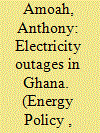

|
|
|
|
|
| Summary/Abstract |
African countries experience persistent and serious energy outages, but while multiple valuation studies provide estimates of the costs of electricity outages in high-income countries, evidence is scarce for lower- and middle-income countries. The few studies that assess the value of reliable energy supply rely on the contingent valuation method that is under wide scrutiny. This paper aims to provide new estimates of households' willingness to pay to reduce electricity outages for Ghana and contributes to the debate on the validity of contingent valuation results for energy reliability. Our results suggest that households are willing to pay GHS 67 ($17) per month for reliable electricity supply, equivalent to 7% of respondents’ income. The results of tests for hypothetical bias, WTP-WTA disparity and income effects suggest that the contingent valuation estimates from this study are robust and can support decision makers in prioritizing energy policies and investments.
|
|
|
|
|
|
|
|
|
|
|
|
|
|
|
|
| 13 |
ID:
169886


|
|
|
|
|
| Summary/Abstract |
The ongoing digitalization of the energy sector opens up opportunities for novel business models which can help to overcome some of the challenges accompanying the sustainable energy transition. One necessity in a more decentralized energy system with high shares of intermittent renewables is the provision of flexibility. This paper empirically applies the business model generation approach of Osterwalder and Pigneur (2010) in order to enhance our understanding of these transition challenges. The insights gained indicate that the focus of business models in the electricity supply market has to switch to a customer-driven perspective. To this end, the conceptual business model of an “Energy Supplier 2.0” as a dedicated aggregator of flexible capacities on the household level is investigated, showing how a specific new energy business model can tap the potential of distributed flexible energy assets. We find that the aggregation of the inherent economic potentials of these flexibilities is suitable to provide additional revenue streams, support grid operators, and promote customers to become “prosumers”. Despite these promising advantages, we find in the case of Germany that the current regulation and policies need to be adapted to achieve a broader diffusion of this type of business model and offer suggestions on the implementation.
|
|
|
|
|
|
|
|
|
|
|
|
|
|
|
|
| 14 |
ID:
169890
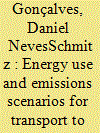

|
|
|
|
|
| Summary/Abstract |
To achieve the mitigation targets discussed under the Paris Agreement, countries must develop studies that not only estimate baselines based on historical data of greenhouse gas (GHG) emissions and energy use, but that also project them considering different levels of ambition and political commitment. This study aims to develop and model scenarios of energy use and GHG emissions from the transport sector until 2030, considering the Brazilian Nationally Determined Contribution (NDC). Three scenarios were developed based on different political commitment. The method is based on a bottom-up approach, requiring multi-sectoral collaborative efforts to not only explain the direct energy use, but also balance the transportation activity and energy between the transport modes, justifying each case in terms of development stage and energy supply capacity. Here, transport sector has been further split up into the highest sector level detail available. At the maximum, GHG emissions could be reduced by 15% (29 Mt CO2e), achieved in scenario 3, whilst there are increases on emissions in scenario 2 (5% or 10 Mt CO2e) and scenario 1 (21% or 42 Mt CO2e). It implies that Brazil has the potential to ratchet up the mitigation targets discussed under the Paris Agreement of the UNFCCC.
|
|
|
|
|
|
|
|
|
|
|
|
|
|
|
|
| 15 |
ID:
169880
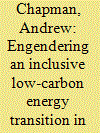

|
|
|
|
|
| Summary/Abstract |
Engendering a low-carbon energy transition is necessary to limit climate change impacts and temperature rises. Ideally, this transition would be inclusive, incorporating all stakeholders, however, the issue of energy or fuel poverty is a major obstacle to this goal. This research investigates energy poverty in Japan using a subjective, multidimensional energy poverty measure, clarifying the linkages between energy poverty and an inclusive, just transition in terms of energy system and policy awareness, behavior and preferences. Through the analysis of an original survey, we uncover that there is a marked difference between low-income and energy poverty households’ environmental awareness, and their subsequent attitude toward the low-carbon energy transition. Currently, the energy poor have a negative attitude toward the low-carbon energy transition in Japan, causing a lack of self-reported engagement which will not engender an inclusive, just transition. Our findings suggest that if the Japanese low-carbon energy transition were to be inclusive, a further 5 percent of households could participate in the low-carbon energy transition through access to solar or renewable energy capital. Findings identify the need for policies targeted at the energy poor, specifically promoting access to solar capital and low-carbon technologies, in addition to existing policies targeted at low-income households.
|
|
|
|
|
|
|
|
|
|
|
|
|
|
|
|
| 16 |
ID:
169905
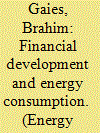

|
|
|
|
|
| Summary/Abstract |
This paper examines the relationship between financial development and energy consumption estimations in the major MENA countries (Algeria, Bahrain, Egypt, Iran, Iraq, Israel, Jordan, Kuwait, Lebanon, Libya, Morocco, Oman, Qatar, Saudi Arabia, Syria, Tunisia, United Arab Emirates and Yemen) over the period 1996 to 2014. We consider the energy use in kg of oil equivalent per capita as a dependent variable that reflects the cross-country energy consumption. We measure the level of financial development in the MENA countries by considering banking indicators. Extending the model of Sadorsky (2011), we estimate both linear and non-linear dynamic panel model. We use new robust econometrics to take into account heterogeneity and nonlinearity and we control the estimation results for the period of the global financial crisis. The results of the study report a positive and statistically significant relationship between the intermediation capacity of the banking system as well as its size and energy consumption. The findings also confirm a non-linear and inverted U-shaped relationship between financial development and energy demand for the MENA region. This implies that initially energy demand increases with financial development and then, at a turning point of financial development, it declines. The policy implications of these results are discussed.
|
|
|
|
|
|
|
|
|
|
|
|
|
|
|
|
| 17 |
ID:
169867
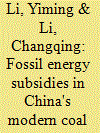

|
|
|
|
|
| Summary/Abstract |
The issue of whether there is a fossil energy subsidy in China's modern coal chemical (MCC) sector remains controversial, although domestic coal prices have been liberalized since 2013. To identify potential fossil energy subsidies in the MCC industry, an inventory approach is used in subsidy measurement. Three representative forms of coal consumption subsidization are identified and measured in this paper: feed coal supply at a preferential price, prior access to coal mining rights, and privilege in coalmine M&A (mergers and acquisitions) cases. Using China's coal-to-liquids (CTL) industry as a case study, we find that the current subsidy helps save 50% of the coal consumption cost of a typical plant, and the total amount of subsidy in the CTL industry will reach 16.4 billion Yuan in 2022. However, according to the results of efficiency, wastefulness and effectiveness tests, 47.03% of the current subsidy in the industry is excessive, leading to overinvestment and energy waste. To compensate for the deficiency of the subsidizing mechanism, we suggest replacing subsidizing channels that rely on mining rights concessions or M&A cases with channels using long-term coal supply contracts that couple contract prices and oil prices.
|
|
|
|
|
|
|
|
|
|
|
|
|
|
|
|
| 18 |
ID:
169881


|
|
|
|
|
| Summary/Abstract |
The UK energy sector has been one of large-scale centralised energy production by big companies, with households seen as passive consumers of energy at the end of wires. The development of renewable energy technologies, such as solar photovoltaics (PV), signals greater potential for small-scale energy production. Such change provides the opportunity for households and communities to become active consumers and producers of energy, as well as for energy service providers to support integration of renewable technologies. Drawing on data from a community energy study, the paper shows how community energy projects can be test beds for developing new business models, leading to empowerment and democratisation as important stepping stones to mainstream community energy. The paper adds to existing knowledge about these challenges by developing possible future pathways to mainstream community energy: top-down; bottom-up; and hybrid. These pathways’ potential contribution to decarbonising the energy sector is considered, with implications for policy, regulation and new business models.
|
|
|
|
|
|
|
|
|
|
|
|
|
|
|
|
| 19 |
ID:
169895
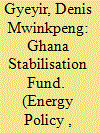

|
|
|
|
|
| Summary/Abstract |
Ghana in response to global best practices in managing volatile petroleum revenues included in its petroleum revenue management framework, the Ghana Stabilisation Fund (GSF). This study sought to evaluate the impact of volatile petroleum receipts on the GSF and measure the effect of discretionary capping on the ‘stabilisation’ role of the Fund since its establishment in 2011. Using qualitative comparative analysis and sensitivity analysis techniques, the study found that transfers into the GSF has been influenced to various degrees by total petroleum receipts, the variance between benchmark and actual revenues, transfers to the National Oil Company and discretion around transfers into the Fund in its initial years of operation. Out of the total of US$ 714,608,340 withdrawn from the GSF between 2014 and 2018, 86.72 percent has been transferred into the Debt Service Account/Sinking Fund (DSA/SF) and used to retire some marketable debt instruments (loans). It concludes that the GSF has impacted minimally on its primary object of cushioning or sustaining public expenditure capacity during periods of unanticipated petroleum revenue shortfalls and that, the Fund has been largely applied for debt repayment purposes than economic stabilisation over the past eight years.
|
|
|
|
|
|
|
|
|
|
|
|
|
|
|
|
| 20 |
ID:
169893


|
|
|
|
|
| Summary/Abstract |
Fuel economy regulation is a powerful instrument to reduce CO2 emissions of vehicles. CO2 emissions from transport have to be dramatically reduced to reach ambitious CO2 targets, but fuel economy standards below 75 gCO2/km (72.8 MPG) cannot be reached with combustion engine vehicles but require plug-in electric vehicles (PEVs). However, the specific relationship between stringent fuel economy standards and PEV market share is unclear. Here, we analyse CO2 fleet targets in Europe where Regulation (EU) 2019/631 sets a target of 59.4 gCO2/km (90.9 MPG) in 2030. We use data of 3.2 million records with model-specific car sales in Europe from 2010 to 2016 to project future sales and CO2 emissions of all major vehicle manufacturers. We analyse the required PEV sales for these manufacturers to fulfill the CO2 targets and compare them to the manufacturers' announced sales targets. Our results demonstrate that regulation's target leads to PEV sales shares between 27 and 41% in 2030. The lower value is required if all manufacturers only sell BEV and the upper if only PHEV. In conclusion, ambitious CO2 fleet regulation leads to fast market diffusion of PEVs, but the current regulation is less ambitious than car maker targets in 2025.
|
|
|
|
|
|
|
|
|
|
|
|
|
|
|
|
|
|
|
|
|